-
Posts
2,168 -
Joined
-
Last visited
Content Type
Profiles
Forums
Gallery
Events
Posts posted by JSGerson
-
-
- KenW, Blue Ensign, CaptainSteve and 1 other
-
 4
4
-
At the other end a large heart had to be installed on the line as well as the deck anchor ring. The kit provided metal hearts that had to be painted or blackened. Since I had come this far making my own, I made these as well. Starting with stock boxwood of the proper size, I drew the outline of the hearts and drilled and filed out the centers. Once completed, I stained them a darkish wood color.
- CaptainSteve, Martin W, usedtosail and 2 others
-
 5
5
-
Main Stay
Basically the Main Stay is made the same way as previous stays except the line is thicker (1.2mm). This required a larger mouse. My previous method would not work well at this dimension so this time used the cone method. A piece of dowel was first drilled with a hole that I could thread the line through. Then using hand files, the dowel was tapered at one end right down to the opening and painted flat black. The line itself was sized where it was to wrap around the mast as well as where it would rub against the foremast. The mouse was threaded on into position and sized into the line. During the sizing process, diluted PVC glue was applied over the mouse sizing to prevent it from slipping off.
- KenW, Martin W, Blue Ensign and 1 other
-
 4
4
-
Thanks all. I am presently away from the builder's bench for a couple days so it will be a couple of more days before the next installment (not that anyone would notice at my work pace).
-
Now for the second learning experience; blackening the metal. The is the other thing I’ve never done. I bought the product Blacken-It. From what I read, you are supposed to dilute it. I diluted it 1:1 with water. Before I dropped in the completed assembly including the deck nails, it got a bath in the cleaning acid and a water rinse. I didn’t know what to expect; I was dealing with four different materials: copper, silver solder, brass, and whatever the nails were made of. The result was interesting. Everything got darker although I would say it was not black, more of a dark brown, a deep rust. This, on a ship, would not be surprising. The deck ring was installed in position according to plans.
- GuntherMT, Rao A.L.G., Martin W and 7 others
-
 10
10
-
After drilling and filing out the opening, the full ring was added and two holes were drilled for some planking nails. These nails would become the rivets once installed to the model. The full ring was not soldered closed to enable it to be installed to the deck plate. The open ring seam would be hidden by the half ring.
- Rao A.L.G., Blue Ensign, Martin W and 2 others
-
 5
5
-
I had previous purchased the following material for the soldering process:
- Cleaning acid
- Silver solder
- Flux
- Self-igniting Hand torch
Following the instructions on the packages plus reviewing various build logs and other resources; I filled my head with enough facts, processes, techniques, do’s, and don’ts to make my head spin. Still, the only way to learn was to do it.
- I cleaned the pieces with the acid and rinsed them in water.
- I coated the area where I was going to solder the half ring with the flux
- I placed the half ring in position with a small piece of solder under the arch of the half ring
- Using the torch I heated the loos assembly carefully so as not to knock over the half ring from the pressure of the hot flowing gas
Voila! As soon as the solder reached melting point it flowed immediately and locked the half ring into place. Unfortunately I used a bit too much solder because it completely filled in the opening.
- Martin W and Blue Ensign
-
 2
2
-
I measured the casting to determine that the ring and the half ring on the deck plate was 3/64” in thickness and I just happen to have some 3/64” brass rod. I had some copper plate and cut it to size to match the cast deck plate. If you look closely you will see two rivets on the deck plate as well.
I curled the brass rod around a mandrel to form a ring the same size as on the casting for both the full ring and the plate half ring.
- Martin W and CaptainSteve
-
 2
2
-
- Blue Ensign, GuntherMT, Martin W and 1 other
-
 4
4
-
I assume you are referring to the gun ports, I copied the elevation (side) view of Harold Hahn's plans and cut and trimmed it so I could lay it on framing to locate each gun port position. The gun ports follow the curved deck line and each are the same height off the deck. I made a mock up of a cannon and placed it on the deck to verify each port height. Don't forget to add the height of the deck planking! You can see how I did it on my log:
-
Just because I'm ahead of you doesn't mean you can't ask questions. Ask away.
-
Just discovered your log today. Thank you for the kudos on the ship's boat. Everything you see on my log I'm experiencing for the first time so beware and read ahead, I make mistakes...lots of them. Hopefully, you won't fall into the same pitfalls I did. Good luck on your build, I look forward to follow it.
Jonathan
-
-
I didn't actual buy a decal kit Per Se. I just bought a small pkg. of decal paper (for inkjet printer in my case) and a 3 oz spray can of Testors Decal Bonder.
- I first print the image on regular paper so I know where it's going to print and to check for scale
- I then taped a piece of decal paper onto the regular piece of printer paper over where the image printed and run it through the printer again.
- Then I spray the bonder over the printed decal paper and let it dry
- I trim off as much of the excess decal paper as possible
- Dunk the decal in water, apply to the model surface, and adjust the position
- When dry, I apply a coat of Micro Sol Settting Solution for Decals to soften the decal so that it tightly conforms to the surface and it conceals the decal edges
- Finally I apply a clear non-gloss (glossy as applicable) coating (usually polyurithane) to the complete surface, not just the decal, which seals it permanently
- usedtosail, CaptainSteve and GLakie
-
 3
3
-
If you are going to print the ship's name you might want to consider the method I used for my Rattlesnake using homemade decals:
Just remember, you cannot print white lettering! There is no white ink. You must print it as a negative with the background color matching the required color of the model area to receive the lettering. The area to receive the decal must be painted white, The printed white lettering will be transparent on the decal and the white area you paint will show through.
- CaptainSteve, GLakie and usedtosail
-
 3
3
-
JerseyCity - Just a thought, could a clear plastic straw been used instead of the bamboo skewer? You could have painted the inside of the straw to give the "lamps" a transparent lens look or would the wire detailing not work with the flimsy plastic?
- GLakie and mattsayers148
-
 2
2
-
wq3296 - The practicum does two things, first for those people like me who never built one of these model before, it was a great help. Second, Bob Hunt's practicum is a kit bash. He deviates from the basic model to give more detail and panache.
Jonathan
-
Now is a good time to review my log so you won't commit the same errors I did to the Captain quarters:
Transom Modification - Somehow my transom came up shorten length which had repercussions further on in the build
The short answer is yes you can customize the bench. I didn't follow Bob's directions completely for the bench either due to previous errors and building technique. However, the visibility on the bench will be limited to just a few viewing angles so don't over do it.
Jonathan
-
Sport - Because I have the plans from Mamoli, MSW, Harold Hahn (Robert Hunt) , and the Smithsonian I can see numerous variations. Looking closer at the MSW plans, the "rings" are labeled "thimbles" and the MSW plan shows what a thimble looks like. What it doesn't say is what the material is. As near as I can figure out based on my "google" research, thimbles were made of metal. So according to MSW you are partial correct. Your wooden "bullseye" should be (?) metal but not a ring as shown in Mamoli. The others plans don't specify the material for this item. Were rings used, were bullseyes used, or thimbles? Your choice.
Scott - it was my build log which lamented that Hunt's Rattlesnake Practicum was rushed at the end, but as I have stated numerous time in different log comments, I could not have built my model without his help. I too have most of Practicums. He had a "sale" a few years ago in which he was selling all of his practicums for the price of one. Since I was and am still planning on building the USS Constitution, I needed that practicum so I ended up getting all that he was offering.
When I get to the Futtock Shrouds I will be taking a crack a silver soldering to make the Futtock Plates. Having never done this before we will see how it goes. If unsuccessful, I will probably follow your lead.
Jonathan
-
Just for your info, the Mamoli plans show a brass ring where you used a bullseye. Who's right, I haven't a clue.
-
I knew that back and forth business was the culprit, but I could make such nice tight seizings with my seizing machine. Yeah, I've got a number of various size needle tweezers, forceps, and what nots, but what I really need is a third or possible forth hand (preferably tiny ones) and my feet and toes just don't cut it! My only excuse (and it's not a good one) is this is my first crack at rigging one of these models where I think I know what I doing (debatable) so I have some slack?
-
The way I have been doing the deadeyes was with a paperclip as you described. I'd wrap the shroud around the deadeye and grab the line tight to the deadeye with a strong clip so the deadeye couldn't move. Then I'd remove the shroud from the model making sure not to disturb the clip and attach shroud line to my seizing machine and seize the line in three places above the deadeye. Then shroud would then be returned to the mast and I do the other end. Trying to seize the line while on the model proved to be messy. I couldn't make a nice clean seizures wrapping the line by hand. I was wondering about how a working ship could keep the deadeyes lined up straight and basically you inferred they can't, so I feel better.
-
The Main Mast shrouds were next. Getting the deadeyes to line up proved to be troublesome. This may have been the result of my seizing the lines off the model using the sizing machine. Once the deadeye was sized, any adjustments to it were impossible.
There was one other hiccup: if you ever drop a tiny part onto the model deck, finding and retrieving it is just a matter of pure luck. If it falls into one of the stairwells, it’s gone. That part will find a nook or cranny to wedge itself in. You will not get it back; period.
This happened with a deadeye. I saw it drop onto the deck and then it vanished. That was it, poof! Because the kit had a finite amount of deadeyes, losing one and getting a replacement part wasn't an option with Mamoli who is now out of business. I had to make one. Luckily I had a leftover piece of a dowel that was the same diameter as the deadeye. I slice off a piece the same thickness as the deadeye and then drilled the three holes. The first time I tried it, I drilled the holes with a hand drill. That didn’t go so well as one hole angled into another. On my second attempt I was successful when I used my Dremel drill press rig. The piece was then hand filed to its final shape and then stained with Early American Min-wax. It worked. In the picture of the deadeyes below, the original one is on the right and my replacement on the left side.
- Blue Ensign, KenW, CaptainSteve and 1 other
-
 4
4
-



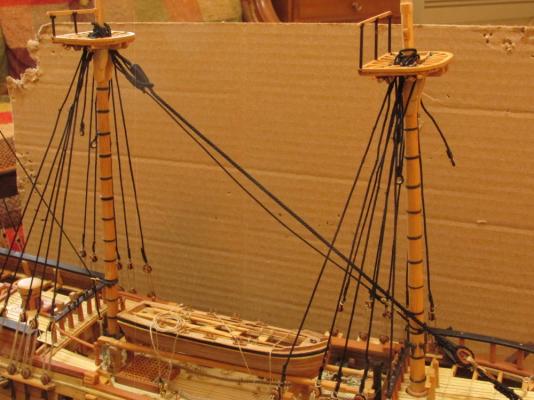
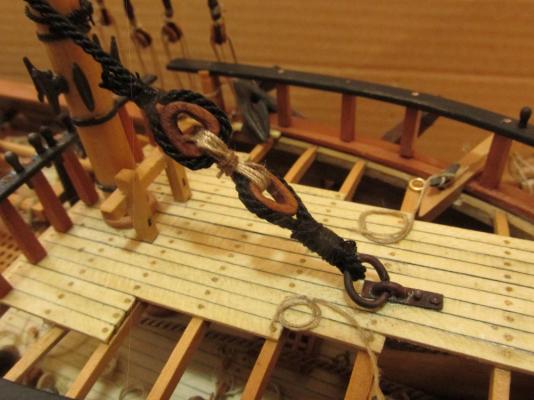
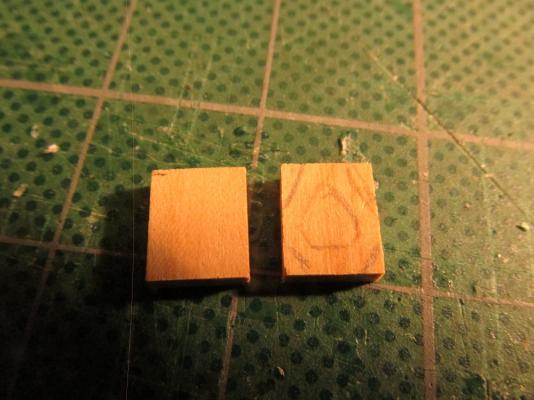
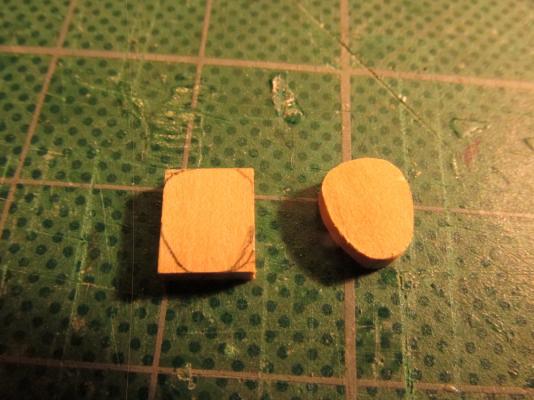
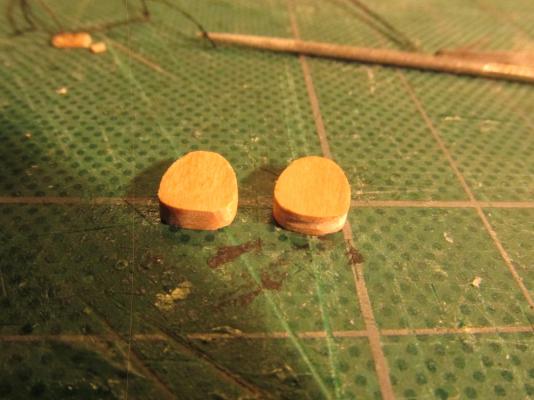
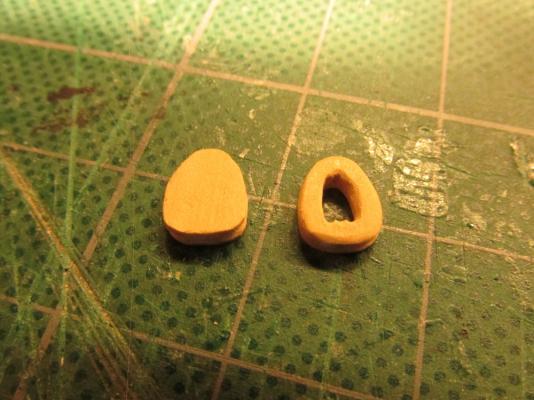
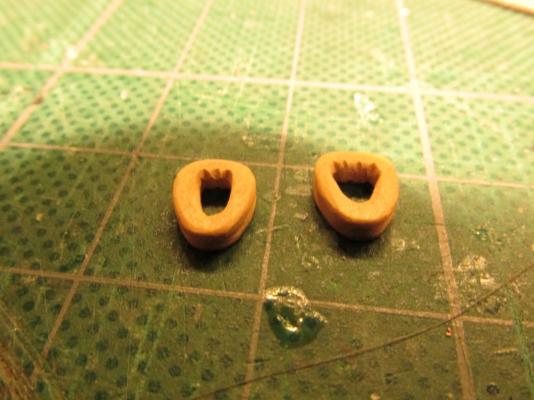
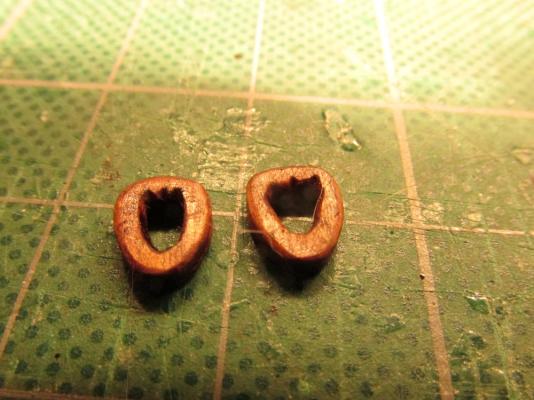

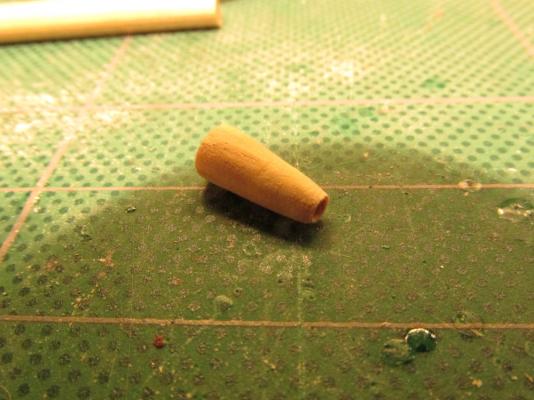
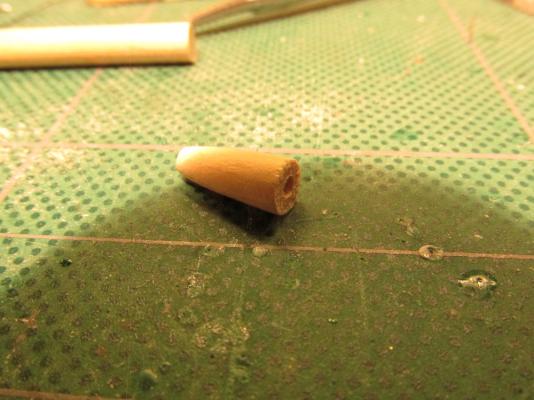
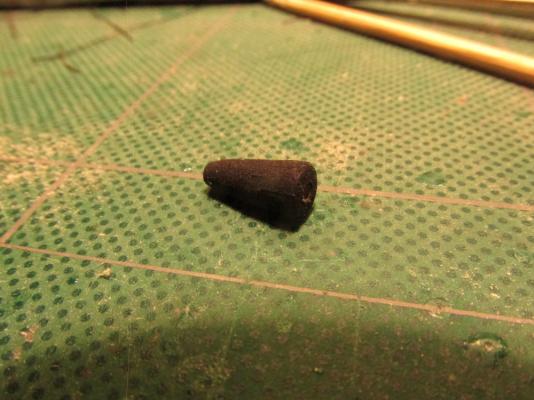
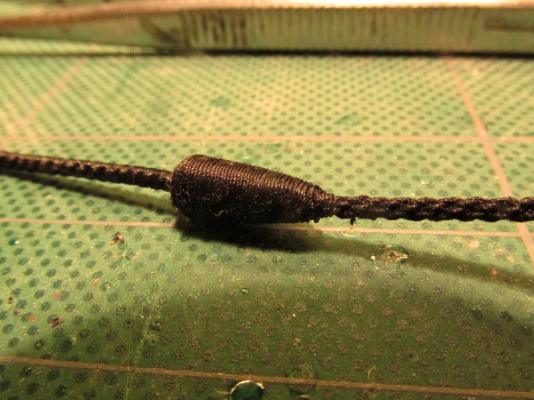
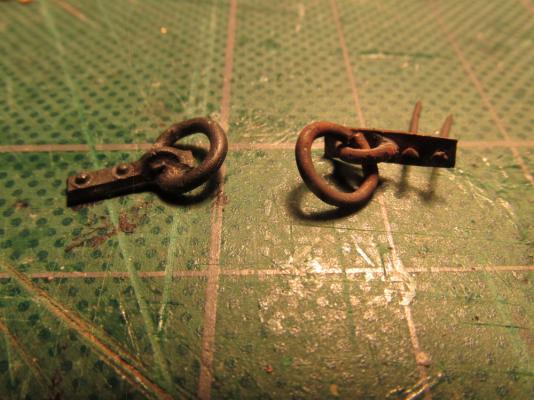
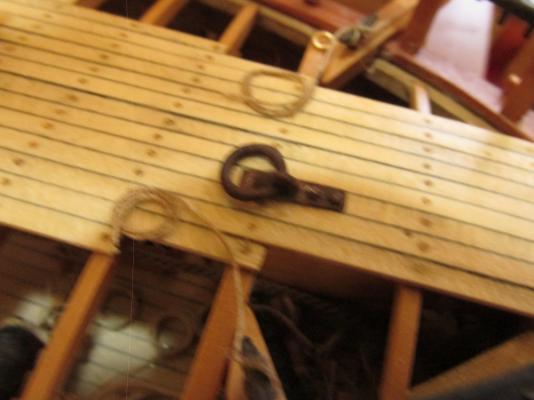
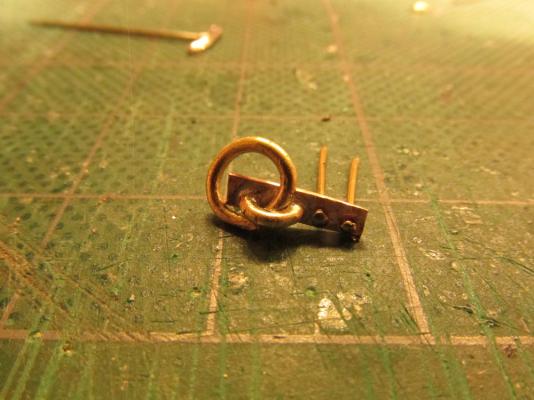
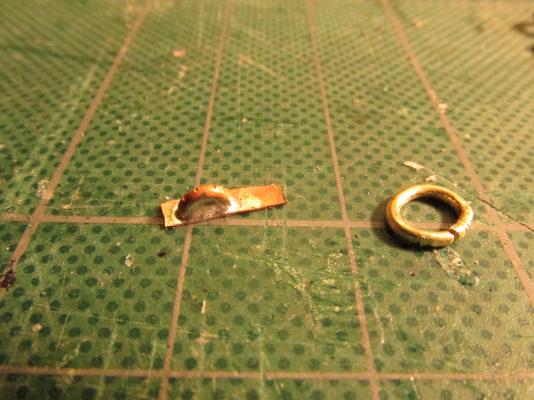
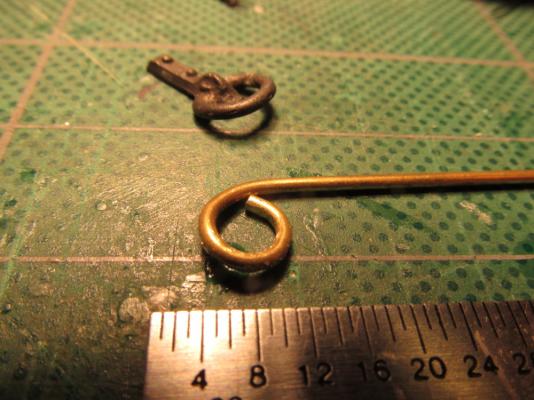
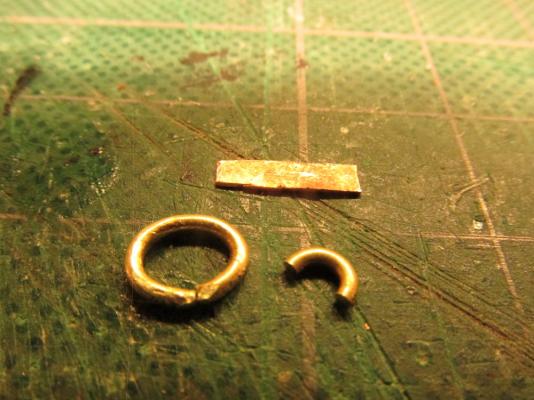
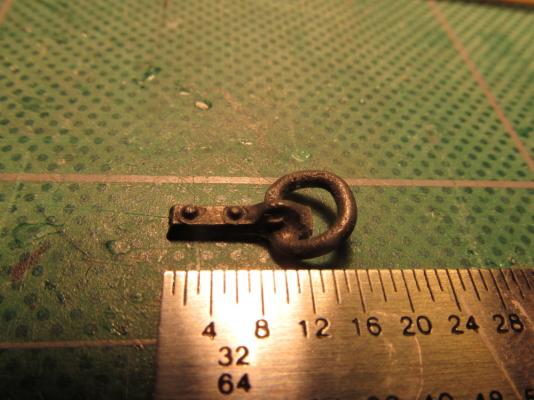
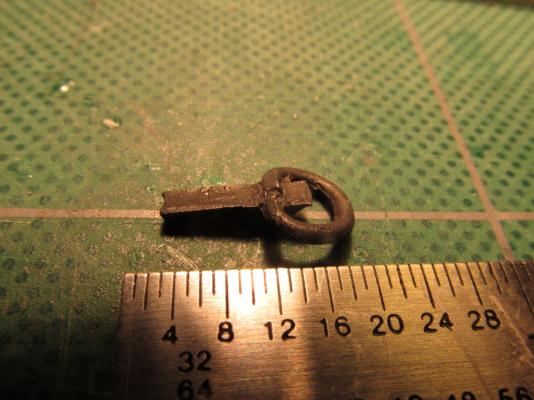

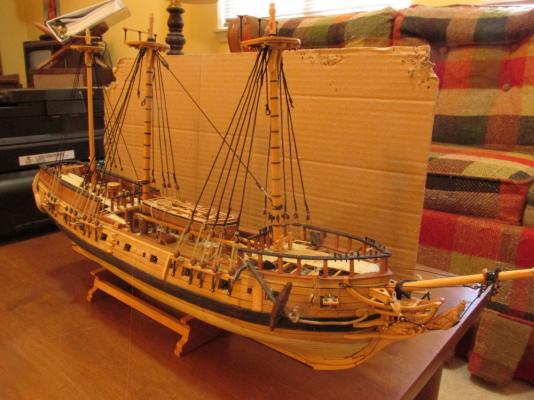
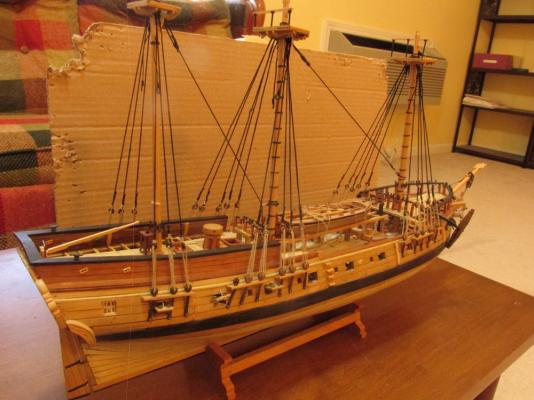
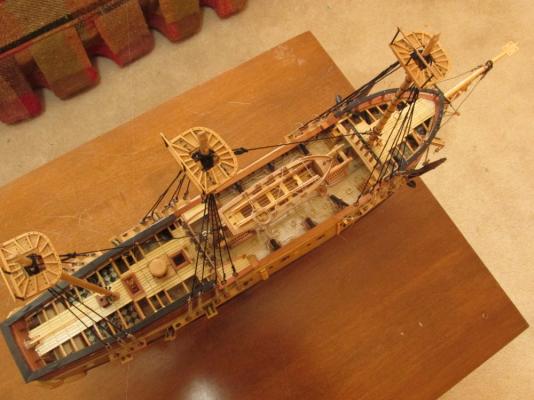
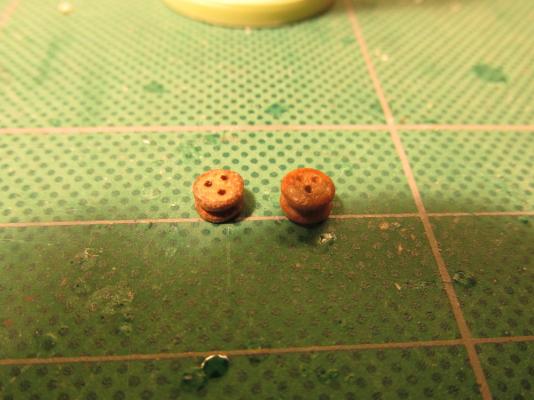
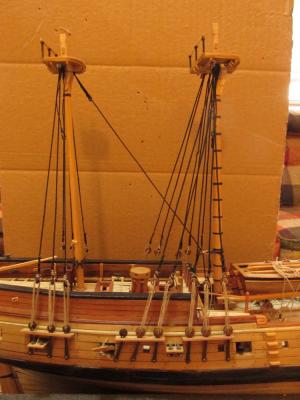
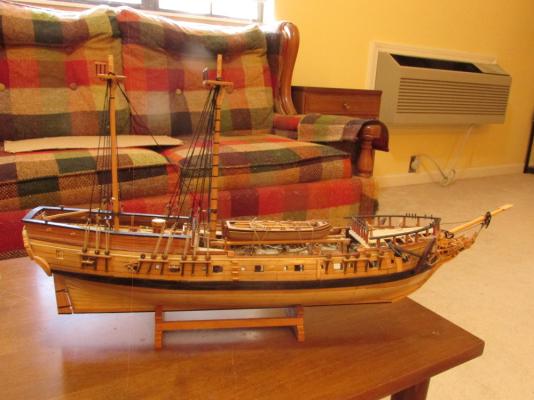
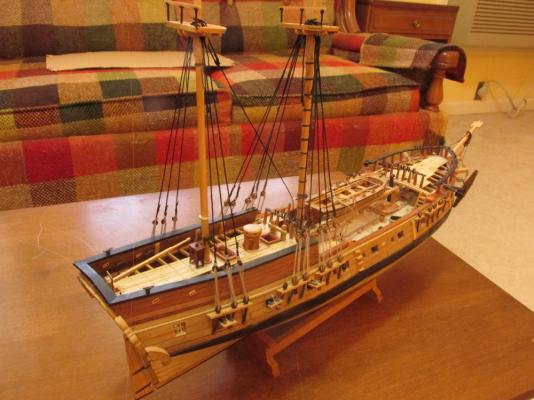
Rattlesnake by JSGerson - FINISHED - Mamoli - 1:64 - Using Robert Hunt’s practicum
in - Kit build logs for subjects built from 1751 - 1800
Posted
Fighting Top Deadeyes
I decided at this point I had better install the deadeyes and straps on the fighting tops before I introduce any more rigging to the masts and make my life more difficult. I had the foresight to install the blocks on the tops before they were installed but in my enthusiasm to start the rigging, I neglected to install the deadeyes and straps as well.
When creating the tops, I tried to follow as closely to the plans as I could, maybe too close. I made the openings for the deadeye straps quite small about 1 x 2 mm. I quickly realized that I could not increase the openings now that they were on the model.
After numerous attempts to create a strap that would embrace the deadeye and fit through the opening, I had to discard any idea of making a loop at the bottom of the strap for the hook connection, discard the idea of using a larger gauge of wire bigger than 0.5 mm even though I thought that would look better, and finally any idea that this would be easy. The wire I ended up using was 0.5mm “beading wire” (the pkg. did not state its metallic composition). I could not find brass wire at the Hobby Lobby in my town, the only hobby store around.